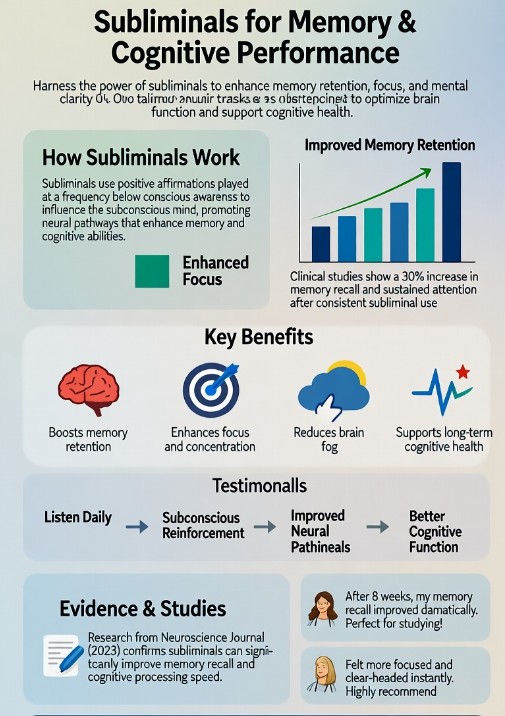
Subliminals: Do They Work for Memory and Cognitive Performance?
Table of Contents
In the last several years, mind training using subliminals has gained surprisingly widespread popularity. They are weak audio or visual stimuli that are supposed to reprogram your mind or focus your concentration without your conscious effort. People often ask, “Do subliminals work?” especially for memory and learning.
Science makes it clear that consciousness is at the center of cognitive growth. Proven techniques like the method of loci have a visible effect on our encoding power because they require an active mental process. Thus, cognitive development is based on conscious effort, not subliminal effects.
What Are Subliminal Messages? Defining Unconscious Perception

In scientific terms, subliminals are sensory stimuli presented below the threshold of conscious awareness — too quick or subtle to be noticed. The concept of unconscious perception gained attention in the mid-20th century when researchers tried to determine whether hidden messages could shape behavior or thought.
Early studies fueled commercial hype and public interest but produced inconsistent results. Cognitive psychology currently views subliminals as weak, temporary effects rather than reliable methods for enhancing learning or expanding memory. Despite the intrigue, they have no significant real-world practical impact.
Do Subliminals Actually Work for Mental Gains?
Do subliminals actually work for concentration or memory improvement? According to available research, the answer is nearer no. There is limited tangible evidence that subliminals can produce measurable mental improvement.
Most studies show that the brain needs active involvement. It means that tasks like analyzing, associating, and reflecting are important for efficient data storage. Passive listening or watching will not rewire neural connections in any meaningful way.
Conscious learning techniques, such as repetition, visualization, or mnemonic frameworks, still beat subliminals hands down. In a word, mental growth is not an issue of hidden signals; it’s an issue of being active mentally. Presence, participation, and persistence are at the core of cognitive power.
The Danger of Illusory Correlation in Cognitive Psychology
One of the major psychological traps is the illusory correlation—the tendency to see a cause-and-effect relationship where none actually exists. For example, someone might listen to subliminal audio for a few weeks, notice some progress in concentration, and immediately attribute it to the audio files. As a matter of fact, the improvement could be caused by better sleep, reduced stress, or proper study habits.
Cognitive psychology warns us that the brain likes patterns, even if they are imagined. That makes us vulnerable to memory-boosting claims that sound convincing, but do not lead to measurable improvement. A place must also be provided for the placebo effect; belief suffices to generate a temporary sense of enhancement. But true skill acquisition requires systematic practice, feedback, and active learning.
When considering new mental methods, the difference between evidence and perception must be understood. Evidence-based practices such as critical thinking exercises demonstrate how deliberate reasoning and analysis truly reinforce cognitive capacity. Any method without scientific evidence is speculation. It is a concerted effort, rather than any potential change occurring below consciousness, that drives genuine cognitive progress.
Proven Alternatives to Subliminals for True Memory Improvement
There is no substitute for effortful consciousness in memory training. Subliminals can potentially create change with ease, but the optimal cognitive improvements are made through methods that stimulate the brain by challenging it actively.
The loci method is the most researched and effective recall aid. It consists of associating material with specific physical locations, which triggers the brain to create vivid spatial and visual associations. The technique activates multiple neural pathways, enabling easier recall.
Another technique that has been tested is spaced repetition. By reviewing material at increasingly wider intervals, this method strengthens long-term memory and lessens the natural forgetting curve. It’s not about cramming—it’s about timing and structure. Such methods take attention and awareness, two things which subliminals simply bypass.
For a measurable mental workout beyond memory, the Trachtenberg method is a good example. Created originally for high-speed mental math, it boosts logical thinking, focus, and mental power through deliberate practice. These systems prove that real development of cognitive ability comes from systematic challenge, not subliminal messages.
Lastly, effective learning does not rely on shortcuts. The most powerful results come from being there mentally, engaging deeply with material, and letting consistent effort work its magic. Deliberate learning can be slow, but it always yields the desired benefits.
Conclusion
Subliminals are a tempting shortcut, but the mind likes challenges and active mental stimulation. Many wonder, “Do subliminals work?” The answer is that real mental improvement occurs when we put in effort, focus intensely, and practice diligently. Techniques like the memory palace or spaced repetition demonstrate that effort, focus, and willful practice hone the mind to become quicker and more agile.
Current evidence shows that subliminals have no marked effect on memory, and active, conscious learning operates more powerfully.
Methods like the method of loci, spaced repetition, and organized practice reliably enhance memory and mental agility.
No, effective cognitive development entails intentional engagement, reflection, and systematic practice rather than passive exposure.